Techno-Economic Evaluation of a Hybrid Energy System for an Educational Institution: A Case Study
Abstract
:1. Introduction
- Determination of the solar rooftop PV system potential and performance using GIS estimation in order to obtain real-time solar data.
- Development of an optimization design for the grid-connected hybrid energy system considering the diesel generator, wind power, solar rooftop PV and battery storage system for technical assessment of the four configuration models for the educational institutions.
- Economic assessment such as the levelized cost of energy (LCOE) of the four system configurations for determining the optimal choice of hybrid energy system configuration suitable for the educational institution.
2. Background
2.1. Description of the Case Study
2.2. Solar Global Horizontal Irradiance
2.3. Daily Load Profile
3. Methodology
3.1. Mathematical Modelling of the HES Components
3.1.1. Rooftop Solar PV Arrangement
3.1.2. Wind Power
3.2. Computation of Economic Variables
3.3. Simulation Process
- Diesel Generator and Utility Grid System (DU);
- Diesel Generator, Utility Grid, Solar PV, Inverter and Battery System (DUP);
- Diesel Generator, Solar PV, Inverter and Battery System (DP);
- Utility Grid, Solar PV, Inverter and Battery System (UP).
4. Results and Discussion
4.1. Power Capacity
4.2. Emissions
4.3. Economic Analysis
5. Conclusions
Author Contributions
Funding
Institutional Review Board Statement
Informed Consent Statement
Data Availability Statement
Conflicts of Interest
References
- Baseer, M.A.; Alqahtani, A.; Rehman, S. Techno-economic design and evaluation of hybrid energy systems for residential communities: Case study of Jubail industrial city. J. Clean. Prod. 2019, 237, 117806. [Google Scholar]
- Gul, M.S.; Patidar, S. Understanding the energy consumption and occupancy of a multi-purpose academic building. Energy Build. 2015, 87, 155–165. [Google Scholar]
- A comparative analysis of generation and transmission expansion planning models for power loss minimization. Sustain. Energy Grids Netw. 2021, 26, 100456.
- Gbadamosi, S.L.; Nwulu, N.I. A multi-period composite generation and transmission expansion planning model incorporating renewable energy sources and demand response. Sustain. Energy Technol. Assess. 2020, 39, 100726. [Google Scholar]
- Gbadamosi, S.L.; Nwulu, N.I.; Siano, P. Harmonics Constrained Approach to Composite Power System Expansion Planning with Large-Scale Renewable Energy Sources. Energies 2022, 15, 4070. [Google Scholar]
- Gbadamosi, S.L.; Nwulu, N.I. Reliability assessment of composite generation and transmission expansion planning incorporating renewable energy sources. J. Renew. Sustain. Energy 2020, 12, 026301. [Google Scholar]
- Murugaperumal, K.; Ajay, P.; Vimal Raj, D. Feasibility design and techno-economic analysis of hybrid renewable energy system for rural electrification. Sol. Energy 2019, 188, 1068–1083. [Google Scholar] [CrossRef]
- Emrani, A.; Berrada, A.; Arechkik, A.; Bakhouya, M. Improved techno-economic optimization of an off-grid hybrid solar/wind/gravity energy storage system based on performance indicators. J. Energy Storage 2022, 49, 104163. [Google Scholar]
- Liu, J.; Wang, M.; Chen, X.; Cao, S.; Yang, H. Techno-economic design optimization of hybrid renewable energy applications for high-rise residential buildings. Energy Convers. Manag. 2020, 213, 112868. [Google Scholar]
- Arabkoohsar, A.; Behzadi, A.; Sulaiman, A. Techno-economic analysis and multi-objective optimization of a novel solar-based building energy system; An effort to reach the true meaning of zero-energy buildings. Energy Convers. Manag. 2021, 232, 113858. [Google Scholar]
- Ahmad, J.; Imran, M.; Khalid, A.; Iqbal, W.; Ashraf, S.R.; Adnan, M.; Ali, S.F.; Khokhar, K.S. Techno economic analysis of a wind-photovoltaic-biomass hybrid renewable energy system for rural electrifi cation: A case study of Kallar Kahar. Energy 2018, 148, 208–234. [Google Scholar]
- Das, B.K.; Alotaibi, M.A.; Das, P.; Islam, M.S.; Das, S.K. Feasibility and techno-economic analysis of stand-alone and grid-connected PV/Wind/Diesel/Batt hybrid energy system: A case study. Energy Strateg. Rev. 2021, 37, 100673. [Google Scholar]
- Akram, F.; Asghar, F.; Asghar, M.; Amjad, W.; Manzoor, M.O.; Munir, A. Techno-economic optimization analysis of stand-alone renewable energy system for remote areas. Sustain. Energy Technol. Assess. 2020, 38, 100673. [Google Scholar]
- Ma, W.; Xue, X.; Liu, G.; Zhou, R. Techno-economic evaluation of a community-based hybrid renewable energy system considering site-specific nature. Energy Convers. Manag. 2018, 171, 1737–1748. [Google Scholar]
- Sawle, Y.; Gupta, S.C.; Bohre, A.K. Socio-techno-economic design of hybrid renewable energy system using optimization techniques. Renew. Energy 2018, 119, 459–472. [Google Scholar]
- Shabestari, S.T.; Kasaeian, A.; Rad, M.A.V.; Fard, H.F.; Yan, W.-M.; Pourfayaz, F. Techno-financial evaluation of a hybrid renewable solution for supplying the predicted power outages by machine learning methods in rural areas. Renew. Energy 2022, 194, 1303–1325. [Google Scholar]
- Lee, M.; Hong, T.; Jeong, J.; Jeong, K. Development of a rooftop solar photovoltaic rating system considering the technical and economic suitability criteria at the building level. Energy 2018, 160, 213–224. [Google Scholar]
- Kabir, M.N.; Mishra, Y.; Ledwich, G.; Xu, Z.; Bansal, R.C. Improving voltage profile of residential distribution systems using rooftop PVs and Battery Energy Storage systems. Appl. Energy 2014, 134, 290–300. [Google Scholar]
- Jung, S.; Jeoung, J.; Kang, H.; Hong, T. Optimal planning of a rooftop PV system using GIS-based reinforcement learning. Appl. Energy 2021, 298, 117239. [Google Scholar]
- Singh, R. Approximate rooftop solar PV potential of Indian cities for high-level renewable power scenario planning. Sustain. Energy Technol. Assess. 2020, 42, 100850. [Google Scholar]
- Tarigan, E. Simulation and Feasibility Studies of Rooftop PV System for University Campus Buildings in Surabaya, Indonesia. Int. J. Renew. Energy Res. 2018, 8, 896–908. [Google Scholar]
- Teofilo, A.; Sun, Q.; Radosevic, N.; Tao, Y.; Iringan, J.; Liu, C. Investigating potential rooftop solar energy generated by Leased Federal Airports in Australia: Framework and implications. J. Build. Eng. 2021, 41, 102390. [Google Scholar] [CrossRef]
- Gbadamosi, S.L.; Nwulu, N.I.; Sun, Y. Multi-objective optimisation for composite generation and transmission expansion planning considering offshore wind power and feed-in tariffs. IET Renew. Power Gener. 2018, 12, 1687–1697. [Google Scholar]
- Nwulu, N.I.; Gbadamosi, S.L. Power Systems and Renewable Energy Systems. In Optimal Operation and Control of Power Systems Using an Algebraic Modelling Language; Springer: Cham, Switzerland, 2021; pp. 1–19. [Google Scholar]
- Gbadamosi, S.L.; Nwulu, N.I. Optimal planning of renewable energy systems for power loss reduction in transmission expansion planning. J. Eng. Des. Technol. 2020, 18, 1209–1222. [Google Scholar]
- Gbadamosi, S.L.; Nwulu, N.I. Optimal Power Dispatch and Reliability Analysis of Hybrid CHP-PV-Wind Systems in Farming Applications. Sustainability 2020, 12, 8199. [Google Scholar]
- Gbadegesin, A.O.; Sun, Y.; Nwulu, N.I. Techno-economic analysis of storage degradation effect on levelized cost of hybrid energy storage systems. Sustain. Energy Technol. Assess. 2019, 36, 100536. [Google Scholar]
- Li, C.; Ge, X.; Zheng, Y.; Xu, C.; Ren, Y.; Song, C.; Yang, C. Techno-economic feasibility study of autonomous hybrid wind/PV/battery power system for a household in Urumqi, China. Energy 2013, 55, 263–272. [Google Scholar]
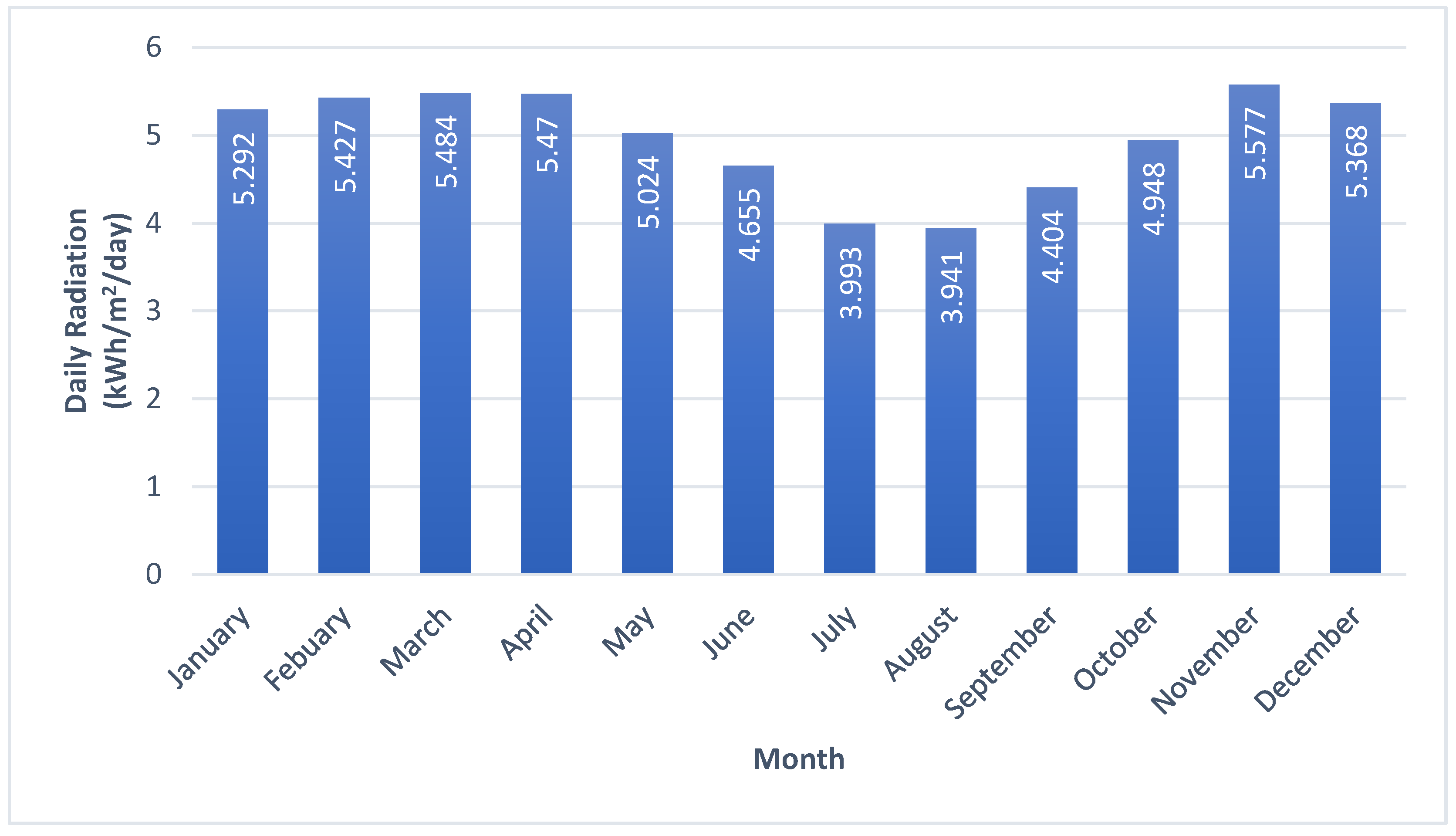

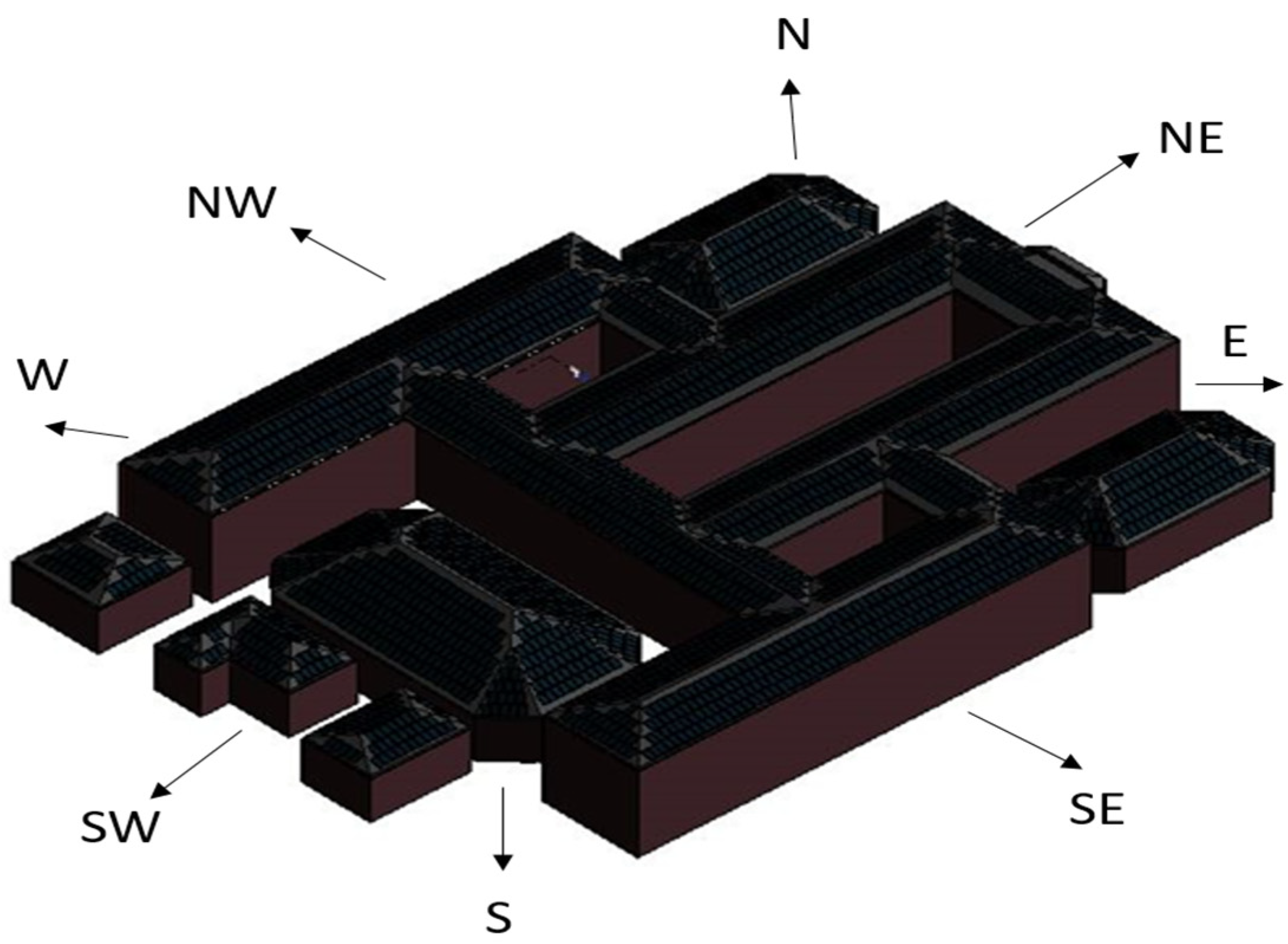
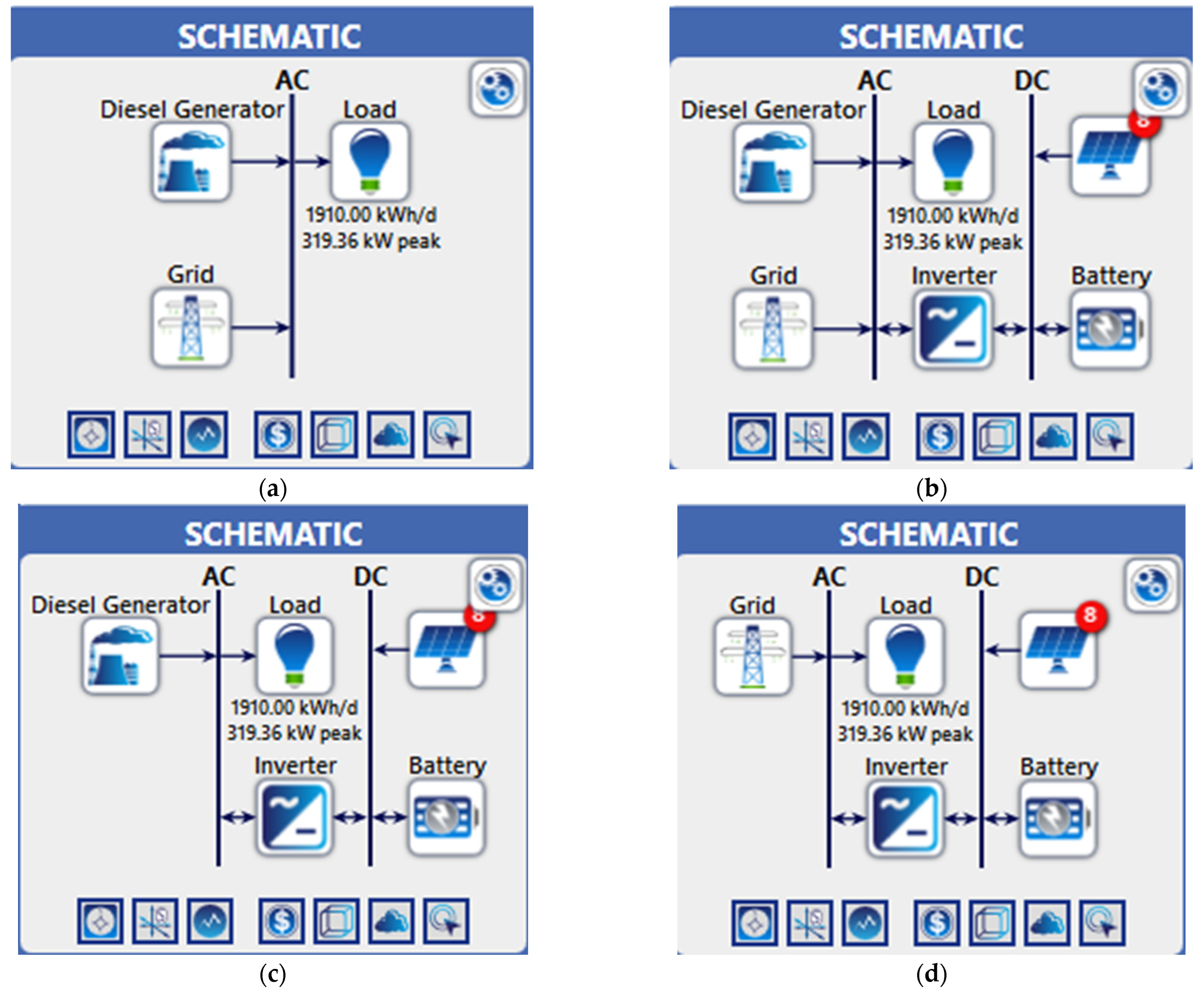
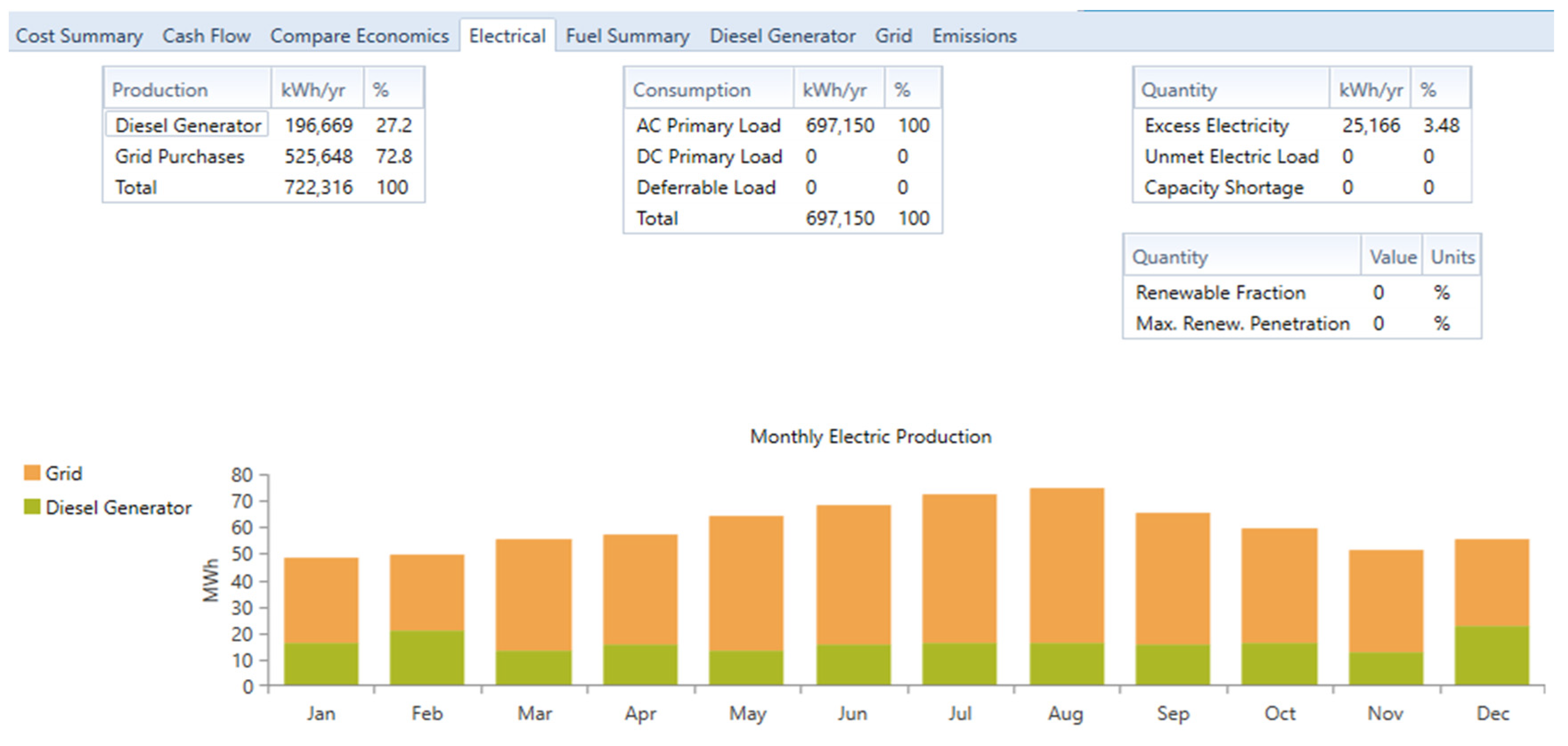


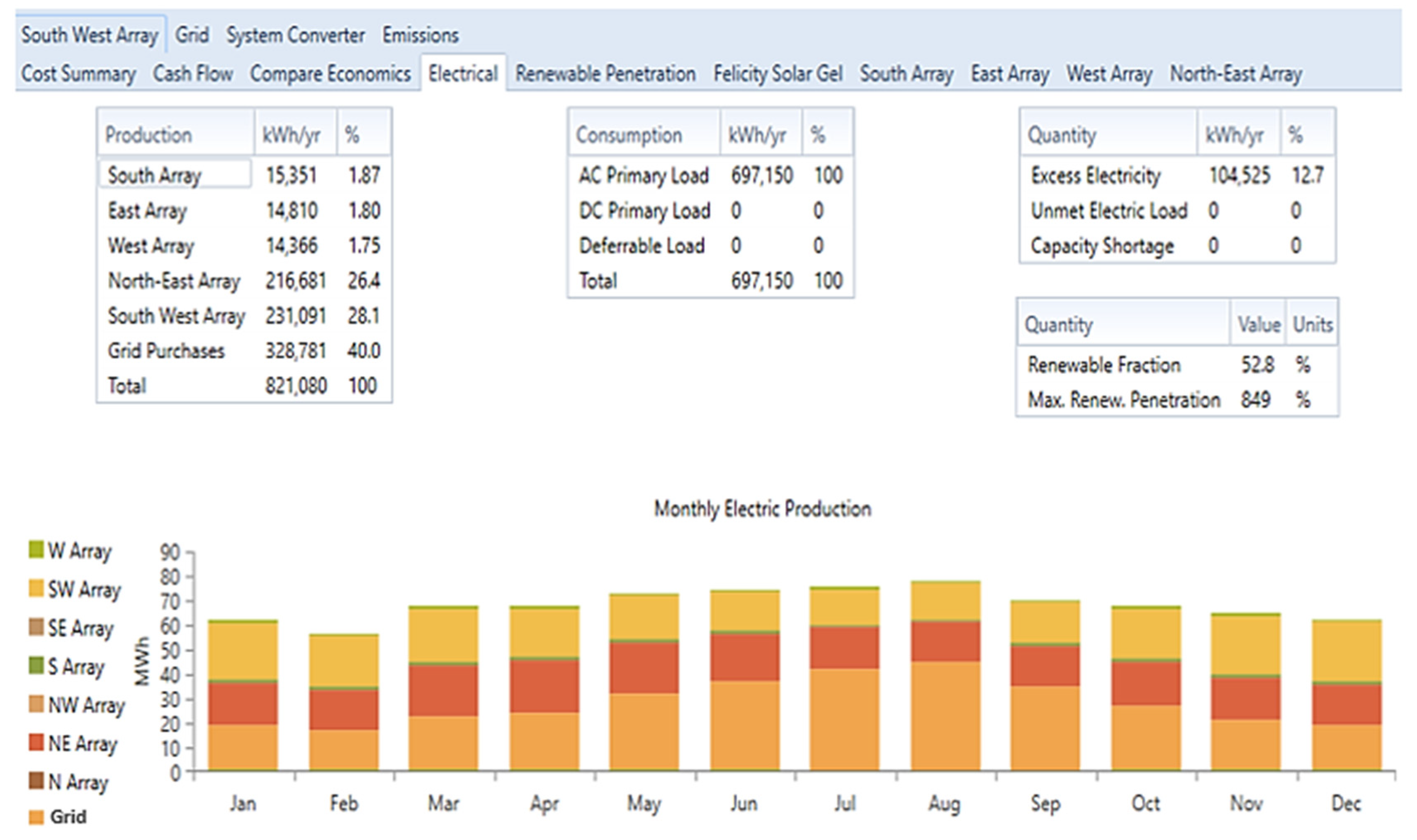
| Orientation | Rated Capacity (kW) |
|---|---|
| North PV Array | 10.5 |
| East PV Array | 10.5 |
| South PV Array | 10.5 |
| West PV Array | 10.5 |
| North-East PV Array | 164.1 |
| North-West PV Array | 293.4 |
| South-East PV Array | 296.4 |
| South-West PV Array | 161.7 |
| Components | DU | DUP | DP | UP |
|---|---|---|---|---|
| Diesel Generator (kVA) | 500 | 500 | 500 | - |
| Grid (kW) | 1743 | 1743 | - | 1743 |
| North PV Array (kW) | - | 10.5 | 10.5 | - |
| East PV Array (kW) | - | 10.5 | 10.5 | 10.5 |
| South PV Array (kW) | - | 10.5 | 10.5 | 10.5 |
| West PV Array (kW) | - | 10.5 | 10.5 | 10.5 |
| North-East PV Array (kW) | - | - | 164.1 | 164.1 |
| North-West PV Array (kW) | - | - | 293.4 | - |
| South-East PV Array (kW) | - | - | 296.4 | - |
| South-West PV Array (kW) | - | 161.7 | 161.7 | 162 |
| Batteries (2500 AH) | - | 24 | 480 | 24 |
| Inverter (kW) | - | 115 | 325 | 160 |
| DU | DUP | DP | UP | |
|---|---|---|---|---|
| Carbon Dioxide (kg/year) | 422,169 | 340,750 | 239,703 | 135,474 |
| Carbon Monoxide (kg/year) | 1064 | 1064 | 1240 | 0 |
| Unburned Hydrocarbons (kg/year) | 56.4 | 56.4 | 65.8 | 0 |
| Particulate Matter (kg/year) | 9.09 | 9.09 | 10.6 | 0 |
| Sulfur Dioxide (kg/year) | 503 | 503 | 586 | 0 |
| Nitrogen Oxides (kg/year) | 204 | 204 | 238 | 0 |
| Total | 424,005 | 342,586 | 241,843 | 135,474 |
| Parameters | DU | DUP | DP | UP |
|---|---|---|---|---|
| LCOE (₦) | 57.14 | 54.96 | 86.85 | 31.26 |
| NPC (₦) | 514,967,400 | 495,329,200 | 782,075,00 | 281,719,600 |
| Operating Cost (₦) | 39,834,980 | 33,135,460 | 27,803,930 | 13,505,270 |
| ROI (%) | - | 6.0 | 5.4 | 8.0 |
| IRR (%) | - | 8.0 | 8.0 | 11.4 |
| Simple Payback (yr) | - | 8.94 | 17.06 | 7.64 |
Publisher’s Note: MDPI stays neutral with regard to jurisdictional claims in published maps and institutional affiliations. |
© 2022 by the authors. Licensee MDPI, Basel, Switzerland. This article is an open access article distributed under the terms and conditions of the Creative Commons Attribution (CC BY) license (https://creativecommons.org/licenses/by/4.0/).
Share and Cite
Gbadamosi, S.L.; Ogunje, F.S.; Wara, S.T.; Nwulu, N.I. Techno-Economic Evaluation of a Hybrid Energy System for an Educational Institution: A Case Study. Energies 2022, 15, 5606. https://doi.org/10.3390/en15155606
Gbadamosi SL, Ogunje FS, Wara ST, Nwulu NI. Techno-Economic Evaluation of a Hybrid Energy System for an Educational Institution: A Case Study. Energies. 2022; 15(15):5606. https://doi.org/10.3390/en15155606
Chicago/Turabian StyleGbadamosi, Saheed Lekan, Fejiro S. Ogunje, Samuel Tita Wara, and Nnamdi I. Nwulu. 2022. "Techno-Economic Evaluation of a Hybrid Energy System for an Educational Institution: A Case Study" Energies 15, no. 15: 5606. https://doi.org/10.3390/en15155606
APA StyleGbadamosi, S. L., Ogunje, F. S., Wara, S. T., & Nwulu, N. I. (2022). Techno-Economic Evaluation of a Hybrid Energy System for an Educational Institution: A Case Study. Energies, 15(15), 5606. https://doi.org/10.3390/en15155606







